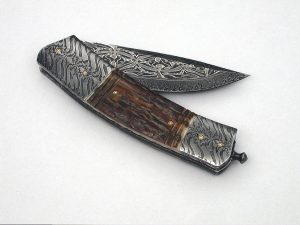What is Damascus Steel?

How Do They Make Damascus Steel?
Origins
The process of making Damascus steel blades has been around for thousands of years. The steel used in the making of Damascus blades is composed of an alloy of metals that provide both strength and flexibility to the blade. The use of these construction materials is ideal for utility blades such as pocket knives or swords. The process of making a Damascus steel blade is more than simply controlling and manipulating the content of the steel; Damascus steel is also the process of folding the steel and producing a blade of the proper hardness.
Forging
Making a Damascus blade begins with multiple pieces of steel. The pieces are a mixture of both high and medium carbon choices, though typically more medium carbon pieces are used. The pieces are sandwiched together, with alternating high and medium carbon pieces, which are bound together with metal wire which is removed after the first weld is placed. The pieces are lengthened to roughly twice their original length, drastically thinning them in the process and further bonding the individual pieces together. The pieces are then removed from the furnace and cut to the proper length. The properly sized piece is folded in order to develop the steel into the layers. The steel which will make up the blade is folded as many times as the smith has the skill for, and as each fold is made, the steel becomes more and more sturdy. Some Damascus steel blades have thousands of layers of steel, all sandwiched together, with the brittle high-carbon steel and the more durable mid-carbon steel coming together to compliment the other. This method is what allows Damascus-style blades to be significantly sharper yet remain more durable than other types of steel blade construction methods. During the folding process, the blade must be constantly cooled and reheated to ensure that the steel is evenly distributed through what will become the blade. After folding, the blade is then hammered into shape. It can also be cut and shaped, though hammering is far more common. If you need help finding steel material for your project, contact Carlson Manufacturing, Inc.
Finishing
After the blade is shaped, it is placed back into the furnace until it reaches at least 1,500 degrees F. After being held at 1,500 degrees F for a few minutes, it is removed and immediately quenched in an oil bath. The blade is then tempered by being heated to 425 degrees F and being held at that temperature for at least two hours. After the blade cools, it is sanded with progressively finer sandpaper, then sharpened. The blade is then etched using an acid mixture of four parts water to one part acid until the acid has eaten away at the softer metal, revealing the Damascus blade pattern.
To see many metal art examples check out Great Manufacturing, LLC.